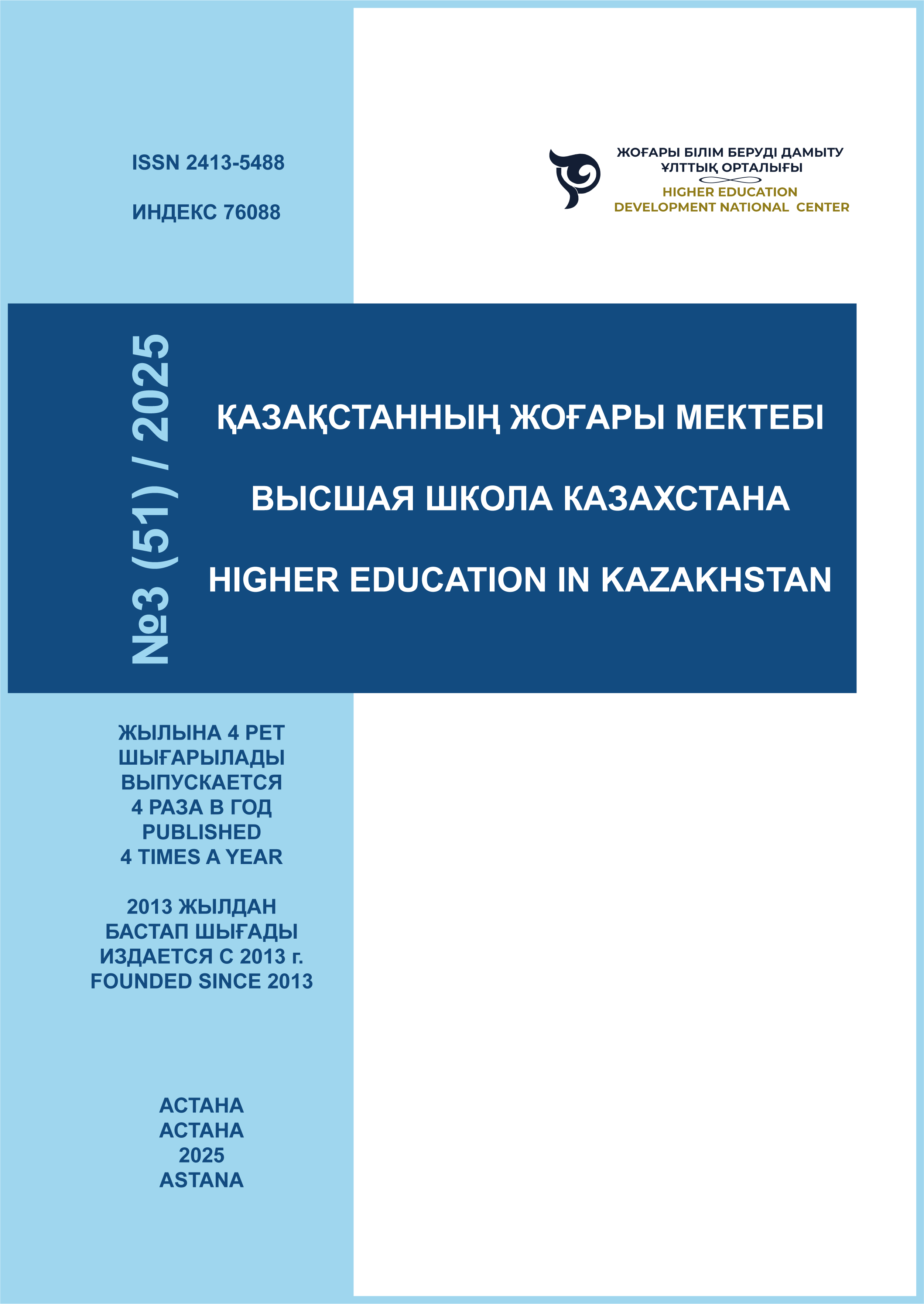METHODS OF TEACHING VOCABULARY OF A SECOND LANGUAGE: LINGUODIDACTIC ASPECTS
DOI:
https://doi.org/10.59787/2413-5488-2025-51-3-5-17Ключевые слова:
teaching vocabulary and word formation, linguistic aspects, contextual teaching, cognitive approach, interlinguistic associationsАннотация
In the context of multilingual education in Kazakhstan, the study of a second foreign language takes on special significance since the formation of a multilingual personality is an important direction of the language policy in Kazakhstan. University teachers face the issue of updating the methodology of teaching a second foreign language within the allocated hours for this discipline. The article is devoted to the study of some methods of teaching the vocabulary of a second foreign language to students with the state language of instruction. The article discusses the linguodidactic principles of teaching vocabulary and word formation of the German language, such as morphological, lexical and conceptual differences between the Kazakh and German languages. These features affect the selection of active vocabulary and require the use of methods that facilitate the process of mastering vocabulary. The purpose of research is to study effective methods of assimilation of lexical units and methods of word formation in the German language. Specific attention is paid to the importance of considering cognitive and linguacultural phenomena when choosing methodological approaches that help adapt the learning process to students. The article presents three effective methods identified through testing during the experiment: contextual learning, the method of interlinguistic associations and contrastive analysis.
The results of the methodological experiment display the efficiency of the proposed methods for the formation of an active vocabulary in the experimental group compared to the control group. The use of these methods allows to reduce the level of difficulties that arise while studying vocabulary in German and contribute to the successful implementation of new lexical units and word-formation models.
The novelty of the study lies in the adaptation and testing of these methods in the context of Kazakhstani multilingual education. The results of the study have practical importance and can be used in the preparation of curricular, massive open online courses and teaching aids for students with the state language of instruction.
Библиографические ссылки
Ballweg S., Drumm S., Hufeisen B., Klippel J., & Pilypaityte L. (2013). Wie lernt man die Fremdsprache Deutsch? Klett-Langenscheidt
Bim I. L. (2001). The concept of teaching a second foreign language (German based on English). Tver.
Bimmel P., & Pampillion U. (2000). Lernautonomie und Lernstrategien, Langenscheidt
Borisenkova L. M. (2005). Cognitive aspects of word formation (based on the German language): Specialty 10.02.04 "Germanic languages”. Doctoral dissertation abstract. Tver.
Chomsky N. (2002). On nature and language. Cambridge University Press.
Dorohova O. A. (2014). Application of the cognitive approach in teaching foreign language vocabulary. Psychology and Pedagogy: Methods and Problems of Practical Application, 35(2), 108-116.https://cyberleninka.ru/article/n/primenenie-kognitivnogo-podhoda-pri- obuchenii-inoyazychnoy-leksike
Dörnyei Zoltán. (2014). Motivation in Second Language Learning. Teaching English as a second or foreign language: Textbook. 33, 518-531.
Fulcher G. (2003). Testing a second language speaking. Longman Pearson Education.
Galskova N.D., & Gez N.I. (2009). Theory of teaching foreign languages. Publishing Center “Akademia”.
Government of the Republic of Kazakhstan. (2019). State Program for the implementation of language policy in the Republic of Kazakhstan for 2020 – 2025. https://adilet.zan.kz/rus/docs/P1900001045
Gureeva A. V. (2022). Development of methods for teaching a second foreign language to students: Using the example of the German language.
Hufeisen B., & Neuner G. (2005). Mehrsprachigkeitskonzept – Tertiärsprachenlernen – Deutsch nach Englisch. Council of Europe Publishing.
Hymes D. (1972). On Communicative Competence. In J.B.Pride & J.Holmes (Eds.), Socioliguistics (pp. 269-293). Penguin.
Johnson E. (2009). Second language teacher education. (1st ed.). Routledge.
Neuner G. (2003). Handbook of Intercultural German Studies. In A. Wierlacher & A. Bogner (Eds), Handbuch interkulturelle Germanistik. (pp. 417-424) J.B. Metzler Verlag, 417-424.
Osiyanova O.M. (2005.) Multilingualism as a defining approach of language policy in modern linguistic education. Bulletin of OGU, 1, 102-106.
Pustovalova T. A. (2014). On the issue of psychological and linguistic content of interference in mastering a second foreign language. Proceedings of the Regional Scientific Conference on Humanities. Yelets: Yelets State University named after I.A. Bunin.
Shukin A.N. (2004). Teaching foreign languages. Theory and practice. Filomatis.
Tirado R. G. (2019). Features of translating fiction from Russian into Spanish. Bulletin of the Peoples' Friedship University of Russia. Series: Linguistics, 23(2), 473-486. https://doi/ 10.22363/2312-9182-2019-23-2-473-486
Sycheva M.N (2015). The phenomenon of interference from the standpoint of psycholinguistics: place and role in the study of foreign languages. Ural Philological Bulletin. Series: Language. D9System. Personality: Linguistics of Creativity, 1, 161-165.

Загрузки
Опубликован
Выпуск
Раздел
Лицензия
Copyright (c) 2025 Научно-аналитический журнал "Высшая школа Казахстана"

Это произведение доступно по лицензии Creative Commons «Attribution-NonCommercial» («Атрибуция — Некоммерческое использование») 4.0 Всемирная.













